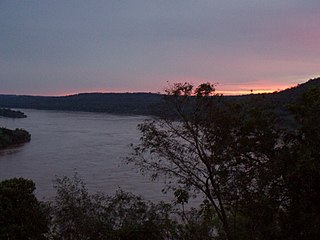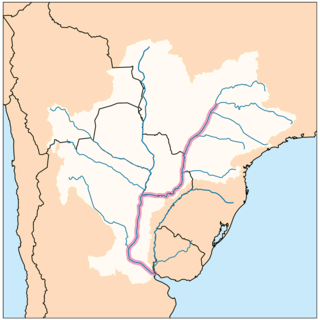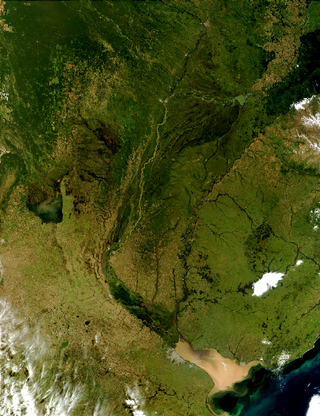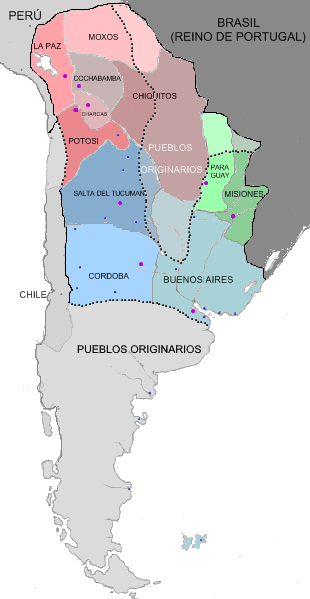Related Research Articles

The Río de la Plata, also called the River Plate or La Plata River in English, is the estuary formed by the confluence of the Uruguay River and the Paraná River at Punta Gorda. It empties into the Atlantic Ocean and forms a funnel-shaped indentation on the southeastern coastline of South America. Depending on the geographer, the Río de la Plata may be considered a river, an estuary, a gulf, or a marginal sea. If considered a river, it is the widest in the world, with a maximum width of 220 kilometres (140 mi).

Upper Peru is a name for the land that was governed by the Real Audiencia of Charcas. The name originated in Buenos Aires towards the end of the 18th century after the Audiencia of Charcas was transferred from the Viceroyalty of Peru to the Viceroyalty of the Río de la Plata in 1776. It comprised the governorships of Potosí, La Paz, Cochabamba, Chiquitos, Moxos and Charcas.

The Uruguay River is a major river in South America. It flows from north to south and forms parts of the boundaries of Brazil, Argentina and Uruguay, separating some of the Argentine provinces of La Mesopotamia from the other two countries. It passes between the states of Santa Catarina and Rio Grande do Sul in Brazil; forms the eastern border of the provinces of Misiones, Corrientes and Entre Ríos in Argentina; and makes up the western borders of the departments of Artigas, Salto, Paysandú, Río Negro, Soriano and Colonia in Uruguay.

The Paraná River (Portuguese: Rio Paraná ; is a river in south-central South America, running through Brazil, Paraguay, and Argentina for some 4,880 kilometres. Among South American rivers, it is second in length only to the Amazon River. It merges with the Paraguay River and then farther downstream with the Uruguay River to form the Río de la Plata and empties into the Atlantic Ocean.

The Viceroyalty of the Río de la Plata meaning "River of the Silver", also called "Viceroyalty of the River Plate" in some scholarly writings, in southern South America, was the last to be organized and also the shortest-lived of the Viceroyalties of the Spanish Empire in the Americas. The name "Provincias del Río de la Plata" was formally adopted in 1810 during the Cortes of Cádiz to designate the Viceroyalty of the Río de la Plata.

The Governorate of the Río de la Plata (1549−1776) was one of the governorates of the Spanish Empire. It was created in 1549 by Spain in the area around the Río de la Plata.

The Sierra de la Plata was a mythical source of silver in the interior of South America. The legend began in the early 16th century when castaways from the Juan Díaz de Solís expedition heard indigenous stories of a mountain of silver in an inland region ruled by the so-called White King. The first European to lead an expedition in search of it was the castaway Aleixo Garcia, who crossed nearly the entire continent to reach the Andean altiplano. On his way back to the coast, Garcia died in an ambush by indigenous people in Paraguay, but survivors brought precious metals back to corroborate their story.
Banda Oriental, or more fully Banda Oriental del Uruguay, was the name of the South American territories east of the Uruguay River and north of Río de la Plata that comprise the modern nation of Uruguay, the modern state of Rio Grande do Sul, Brazil, and part of the modern state of Santa Catarina, Brazil. It was the easternmost territory of the Viceroyalty of the Río de la Plata.

The United Provinces of the Río de la Plata, earlier known as the United Provinces of South America, was a name adopted in 1816 by the Congress of Tucumán for the region of South America that declared independence in 1816, with the Sovereign Congress taking place in 1813, during the Argentine War of Independence (1810–1818) that began with the May Revolution in 1810. It originally comprised rebellious territories of the former Spanish Viceroyalty of the Río de la Plata dependencies and had Buenos Aires as its capital.

Argentina is ultimately derived from the Latin argentum "silver" and the feminine of the adjectival suffix -inus. The first use of the name "Argentina" can be traced back to the first voyages made by the Spanish and Portuguese conquistadors to the Río de la Plata in the first years of the 16th century.

The Cisplatine War, also known as the Argentine-Brazilian War or, in Argentine and Uruguayan historiography, as the Brazil War, the War against the Empire of Brazil or the Liberating Crusade in Uruguay, was an armed conflict in the 1820s between the United Provinces of the Río de la Plata and the Empire of Brazil over Brazil's Cisplatina province, in the aftermath of the United Provinces' and Brazil's independence from Spain and Portugal respectively. It resulted in the independence of Cisplatina as the Oriental Republic of Uruguay.

The Río de la Plata basin, more often called the River Plate basin in scholarly writings, sometimes called the Platine basin or Platine region, is the 3,170,000-square-kilometre (1,220,000 sq mi) hydrographical area in South America that drains to the Río de la Plata. It includes areas of southeastern Bolivia, southern and central Brazil, the entire country of Paraguay, most of Uruguay, and northern Argentina. Making up about one fourth of the continent's surface, it is the second largest drainage basin in South America and one of the largest in the world.
The Real Audiencia of Charcas was a Spanish audiencia with its seat in what is today Bolivia. It was established in 1559 in Ciudad de la Plata de Nuevo Toledo and had jurisdiction over the Governorate of Charcas, Paraguay and the Governorate of the Río de la Plata, modern-day Uruguay and northern Argentina.
This court oversaw the incredible silver output of the mines at Potosí. It was part of the Viceroyalty of Peru until 1776, when it was transferred to the newly created Viceroyalty of the Río de la Plata and began to be referred to as Upper Peru.

The Rio de la Plata Craton (RPC) is a medium-sized continental block found in Uruguay, eastern Argentina and southern Brazil. During its complex and protracted history it interacted with a series other blocks and is therefore considered important for the understanding of the amalgamation of West Gondwana. Two orogenic cycles have been identified in the RPC: a 2000 Ma-old western domain representing the old craton and a 700–500 Ma-old eastern domain assigned to the Brasiliano Cycle. It is one of the five cratons of the South American continent. The other four cratons are: Amazonia, São Francisco, Río Apa and Arequipa–Antofalla.

Cisplatina was a Brazilian province in existence from 1821 to 1828 created by the Luso-Brazilian invasion of the Banda Oriental. From 1815 until 1822 Brazil was a constituent kingdom of the United Kingdom of Portugal, Brazil and the Algarves. After the independence of Brazil and the formation of the Empire of Brazil the Cisplatina province remained part of it. In 1828, following the Preliminary Peace Convention, the Cisplatina province became independent as Uruguay.

The Real Audiencia de Buenos Aires, were two audiencias, or highest courts, of the Spanish crown, which operated in Buenos Aires. The jurisdiction of the first covered the territory of the Governorate of the Río de la Plata and operated from 1661 to 1671. The second began to function in 1783 and had jurisdiction over the parts of the Viceroyalty of the Río de la Plata not covered by the Audiencia de Charcas, that is to say the intendancies of Buenos Aires, Córdoba del Tucumán, Salta del Tucumán and Paraguay. In 1810, after the May Revolution, it was suspended, and in 1813 the Assembly of the Year XIII permanently abolished it. The Audiencias operated in the city's cabildo building.
The Preliminary Peace Convention was a bilateral treaty signed on 27 August 1828 between the Empire of Brazil and the United Provinces of the Río de la Plata, after British mediation, that put an end to the Cisplatine War and recognized the independence of Uruguay.

Francisco Javier de Elío y Olóndriz, was a Spanish soldier, governor of Montevideo. He was also instrumental in the Absolutist repression after the restoration of Ferdinand VII as King of Spain. For this, he was executed during the Trienio Liberal.

The Evangelical Church of the River Plate is a United, Protestant denomination with congregations in Argentina, Paraguay, and Uruguay. It is named after the Río de la Plata Basin, where the majority of its congregations are located. The IERP was affiliated with the Evangelical Church in Germany from 1934–1965, when it became independent. The church ordains women as ministers and supported civil unions and same-sex marriage. It has approximately 27,500 members.

The Governorate of Paraguay, originally called the Governorate of Guayrá, was a governorate of the Spanish Empire and part of the Viceroyalty of Peru. Its seat was the city of Asunción; its territory roughly encompassed the modern day country of Paraguay.
References
- ↑ "Río de la Plata". Encyclopædia Britannica . Retrieved 2010-08-11.